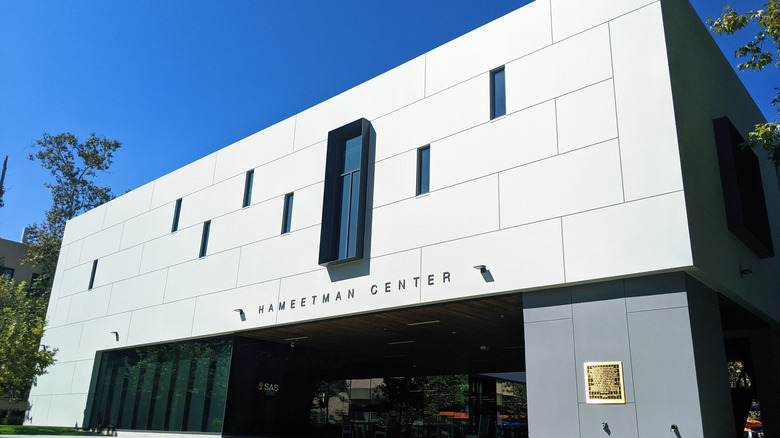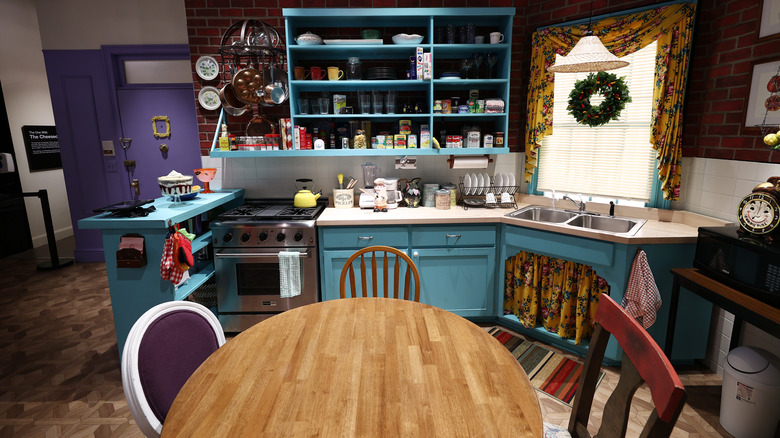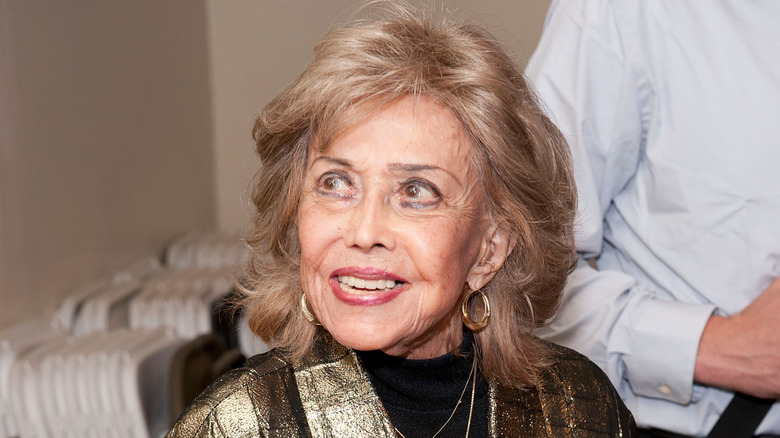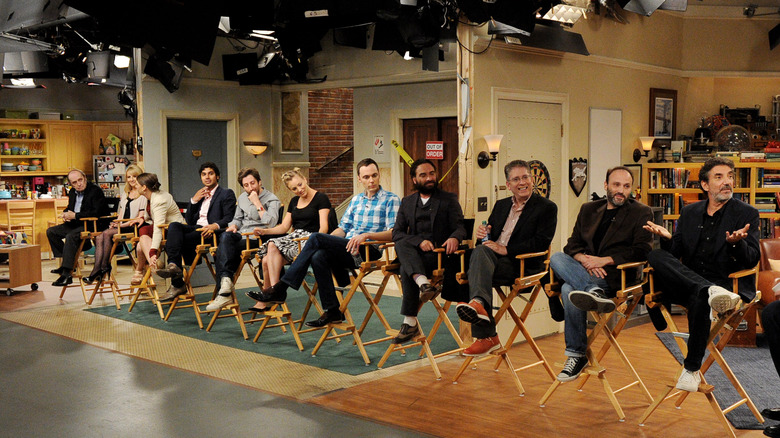The Truth About The Big Bang Theory Apartment Building
For 12 seasons, the CBS sitcom, "The Big Bang Theory," entertained the public. The series showcased the daily antics of several research scientists, including roommates Sheldon Cooper (Jim Parsons) and Leonard Hofstadter (Johnny Galecki), along with their friends Howard Wolowitz (Simon Helberg) and Rajesh "Raj" Koothrappali (Kunal Nayyar). Nearly 18 million people watches the series conclusion of the show that ran from 2007 to 2019, according to Forbes, quoting Nielsen's ratings.
"The Big Bang Theory" ended as the number one sitcom on television, a status it maintained for most of the last eight years of its run. During that time, much of the show's action occurred in Sheldon and Leonard's corner apartment, 4A. The space became a hub for the four friends and the people that come into their lives. Howard dubs it "Nerdvana" in the Season 1 episode "The Nerdvana Annihilation," in which Leonard buys a movie prop of a full-size time machine (via The Big Bang Theory website).
Penny (Kaley Cuoco), Leonard's longtime love interest, lives across the hall in 4B until Season 7's final episode, "The Gorilla Dissolution," according to Today; that's when the two become engaged. Thereafter, Penny spends most of her time in 4A with Leonard and Sheldon until the two lovebirds move across the hall in "The 2003 Approximation" episode (as per IMDb). Throughout the show, the apartment building serves as the predominant setting of "The Big Bang Theory," and almost becomes a star itself.
The Big Bang Theory apartment's exact address is debated
Apartment 4A in "The Big Bang Theory" is supposedly located in a residential complex on 2311 North Los Robles Ave. in Pasadena, California — a fictional address, according to L.A.ist. The publication also points out that fans believe the place was modeled after the real-life Brookmore Apartments because it features similar characteristics of the building, like the fact that the elevator is always broken and the stairwell circles around the lift's space. It even contains exposed brick, and physicists from the California Institute of Technology (see one of the school's buildings above) and NASA's Jet Propulsion Laboratory (where some of "Big Bang's" characters work) live there.
Some followers of "The Big Bang Theory" noted that during an episode in Season 5 — "The Countdown Reflection," in which Howard and Bernadette get married on the building's rooftop as Google Earth captured them, summarized IMDb — satellite footage seems to indicate the apartment is actually on 215 South Madison Ave. That, of course, is just a trick of filming and not the fictional building's address. "I guess they just picked a random spot to use," Lindsay Blake said to L.A.ist. "What they did was they took an aerial view, and they morphed it a little bit."
The Big Bang Theory apartment is not the same as the Friends apartment
While "The Big Bang Theory" and "Friends" share many similarities — they're both about a group of friends; the storylines take the characters through life stages, from being single to having families; and their homes contain much of the plot's actions — the sets are different. While the floor plans for the spaces both feature spacious living rooms and kitchens — like Monica (Courteney Cox) and Rachel's (Jennifer Aniston) apartment, perfect places for the scenes to unfold in — "The Big Bang Theory" and its spaces also seem a bit off. Their apartment, for instance, avoids right angles, according to Gadgets 360, making the room seem elongated and slightly askew.
Both "Friends" and "The Big Bang Theory" also show rental spaces seemingly out of reach of the occupant's salaries. Both shows take place in expensive cities, New York City and Pasadena. While Monica explained that her large sized apartment with a balcony only cost $200 because of rent control, she allegedly inherited it from her grandmother. As for "The Big Bang Theory," the show never offered an explanation on how a Cheesecake Factory waitress afforded her place. It remains a sitcom mystery — although the show did offer some insight with an occasional storyline about Penny's need for extra money (like "The Financial Permeability" episode in Season 2, during which the boys try to convince her ex-boyfriend, Kurt, to pay back a loan (from The Big Bang Theory website).
The secret meaning in The Big Bang Theory apartment 4A
"The Big Bang Theory" likes to throw out thinly veiled references — also known as Easter eggs — as tributes to people, places, and things via the clothing worn, the word choices used in the dialog, or actual name-dropping. You can see this in many episodes. For instance, Sheldon shows his favorite number is 73 by often wearing it on his T-shirts. But there is a significance to it: 1973 is actor Jim Parson's birth year. Of course, Sheldon likes the number because it's unique; as he says, "73 is the 21st prime number. Its mirror, 37, is the 12th and its mirror 21, is the product of multiplying 7 and 3 ... and in binary, 73 is a palindrome, 1001001, which backward is 1001001" (via CBR.com).
Some believe that Apartment 4A is also one of those Easter eggs. Dipley points out that "4A" sounds similar to foray — a word that means a sudden attack or a journey into enemy territory for a purpose like a raid. Or it could also refer to June Foray, who voiced the popular Cartoon animal, Rocky the Flying Squirrel.
The Big Bang Theory set depicts its characters accurately
The characters on "The Big Bang Theory" have distinct personalities and interests and those are reflected in their homes. "Being on those sets, seeing the detail and production design — they're all authentic," actor Simon Helberg (Howard) explained to CNN. For example, Sheldon and Leonard's place embraced who they were with "Star Wars" paraphernalia, figurines from "The Lord of the Rings" and lots of comic books. The show even got a $10,000 sword from "Games of Thrones" for an episode.
Some of the props stay remain in apartment for long periods, while others pop up for an episode or two. Some items even have a storyline of their own, like Sheldon's spot, a place he always must sit in because of its optimal comfort. "I do have a unique relationship with [Sheldon's spot] on the couch," said actor Jim Parsons (Sheldon). "We do a lot of scenes in that apartment set and, as an actor, one of the first things you figure out is where you will physically start a scene on the stage and, nine times out of 10, I start on the spot on that couch. It's as close as I think I'll ever get to Archie Bunker's chair."
The secret of the stairs in The Big Bang Theory apartment
The serpentine staircase is the centerpiece of "The Big Bang Theory" apartment, and the show often moves plot points as characters climb up and down its three flights of stairs. While the elevator broke long before Kaley Cuoco (Penny) became a building resident, she learns the story of its demise during the Season 3 episode, "The Staircase Implementation," when Leonard told her how he met Sheldon and what really happened to that elevator (via TBS). When Cuoco appeared on "The Late Late Show with James Cordon" just before the series concluded, the host asked her how she wanted the show to end. Cuoco replied that she longed for "the elevator to get fixed," and that the stairs had gotten more exhausting as the series progressed.
The actual prop staircase the cast used, though, barely went up a flight. "Guests are always interested in the stairwell, and that it only goes down about seven steps and there's a wall there," explained Johnny Galecki (Leonard) to CNN. "You'd think they would have given us more room. We really have to pack ourselves like sardines to be out of the camera's view — the Hollywood magic that is never quite as glamorous as one might imagine." That's show business, as they say.





